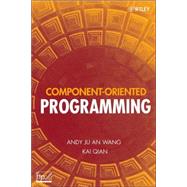
What is included with this book?
KAI QIAN, PHD, is Professor and Department Chair of Software Engineering at the School of Computing and Software Engineering, Southern Polytechnic State University. He has taught component-based software development courses and has completed a number of research projects in component-based software engineering. Dr. Qian has also published extensively in various professional journals and international conference proceedings.
| Preface | ix | ||||
|
1 | (15) | |||
|
1 | (2) | |||
|
3 | (2) | |||
|
5 | (2) | |||
|
7 | (1) | |||
|
8 | (2) | |||
|
10 | (1) | |||
|
11 | (1) | |||
|
12 | (2) | |||
|
14 | (2) | |||
|
14 | (2) | |||
|
16 | (21) | |||
|
16 | (2) | |||
|
18 | (2) | |||
|
20 | (1) | |||
|
21 | (5) | |||
|
26 | (1) | |||
|
26 | (6) | |||
|
32 | (1) | |||
|
33 | (2) | |||
|
35 | (2) | |||
|
35 | (2) | |||
|
37 | (51) | |||
|
37 | (1) | |||
|
38 | (26) | |||
|
64 | (8) | |||
|
72 | (4) | |||
|
76 | (7) | |||
|
83 | (2) | |||
|
85 | (1) | |||
|
86 | (2) | |||
|
87 | (1) | |||
|
88 | (58) | |||
|
88 | (2) | |||
|
90 | (10) | |||
|
100 | (4) | |||
|
104 | (1) | |||
|
105 | (37) | |||
|
142 | (1) | |||
|
143 | (1) | |||
|
143 | (1) | |||
|
144 | (2) | |||
|
145 | (1) | |||
|
146 | (48) | |||
|
146 | (3) | |||
|
149 | (24) | |||
|
173 | (3) | |||
|
176 | (8) | |||
|
184 | (5) | |||
|
189 | (1) | |||
|
190 | (1) | |||
|
191 | (1) | |||
|
192 | (2) | |||
|
192 | (2) | |||
|
194 | (44) | |||
|
194 | (4) | |||
|
198 | (6) | |||
|
204 | (8) | |||
|
212 | (3) | |||
|
215 | (9) | |||
|
224 | (10) | |||
|
234 | (1) | |||
|
234 | (1) | |||
|
235 | (1) | |||
|
236 | (2) | |||
|
237 | (1) | |||
|
238 | (29) | |||
|
238 | (1) | |||
|
239 | (8) | |||
|
247 | (3) | |||
|
250 | (2) | |||
|
252 | (9) | |||
|
261 | (2) | |||
|
263 | (2) | |||
|
265 | (2) | |||
|
266 | (1) | |||
|
267 | (48) | |||
|
267 | (14) | |||
|
281 | (12) | |||
|
293 | (4) | |||
|
297 | (2) | |||
|
299 | (12) | |||
|
311 | (1) | |||
|
312 | (1) | |||
|
313 | (1) | |||
|
314 | (1) | |||
|
314 | (1) | |||
| Index | 315 |
The New copy of this book will include any supplemental materials advertised. Please check the title of the book to determine if it should include any access cards, study guides, lab manuals, CDs, etc.
The Used, Rental and eBook copies of this book are not guaranteed to include any supplemental materials. Typically, only the book itself is included. This is true even if the title states it includes any access cards, study guides, lab manuals, CDs, etc.